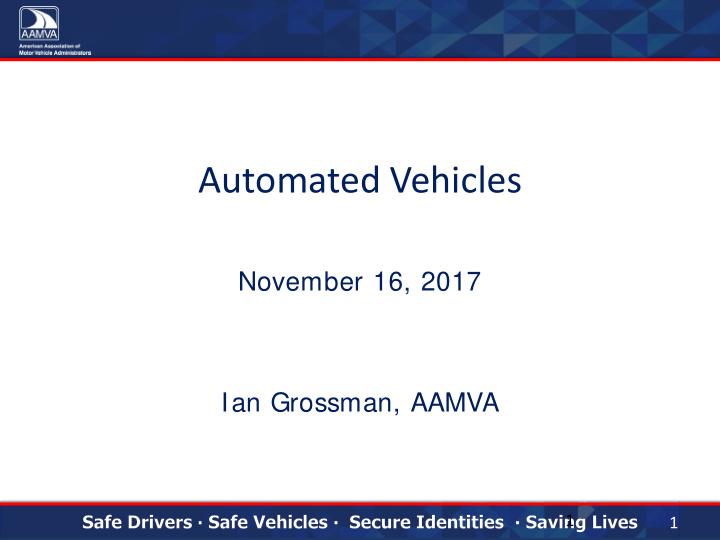



Automated Vehicles November 16, 2017 Ian Grossman, AAMVA 1 1
1. AAMVA Automated Vehicle Working Group 2. NHTSA Automated Vehicle Policy 2.0 3. Federal Legislation 4. State Approaches 2 2
The AVWG The Working Group established fall 2014 Focusing on issues impacting testing and deployed vehicles: • Drivers: Education, Testing, Licensing • Vehicles: Permits, Registration and Title • Law Enforcement: Concerns & Challenges 3
“Jurisdictional Guidelines for the Safe Testing and Deployment of Highly Automated Vehicles” Report Outline 4 Sections 1. Introduction 2. Vehicle Classification, Terms and Technologies 3. Guidelines 4. Next Steps 4
SAE International Classifications, Terms, and Definitions Concise summary of guidelines for jurisdictions: • Administration • Vehicle • Driver • Law Enforcement 5
• Establish a lead agency and stakeholder committee • Develop a strategy for addressing testing and deployment • Examine laws and regulations in order to address unnecessary barriers • Establish statutory authority • Use NHTSA’s guidance and this report to frame regulations 6
• Application and permit to test AVs • Automated Vehicle identification on registrations, titles and MCOs • Use of standard license plates • Insurance for testing and deployed vehicles 7
• Defines and discusses driver and passenger roles • Driver license requirements for testing vehicles • Driver training for consumers purchasing deployed vehicles • Driver Training for Motor Vehicle Agency Examiners, Driver Education Programs and Private Instructors • Driver License Skills Testing • Endorsements and Restrictions not recommended 8
• Crash and incident reporting • Criminal Activity • Distracted Driving • Enforcement of Permit Conditions • Establishing Operational Responsibility • First Responder Safety • Law Enforcement/First Responder Training • Response to Emergency Vehicles, Manual Traffic Controls and Atypical Road Conditions 9 • System Misuse and Abuse
AUTOMATED DRIVING SYSTEMS 2.0 A Vision for Safety Published September 12, 2017 Contains Two Sections: 1. Voluntary Guidance; and 2. Technical Assistance to States 10
Section 1: Voluntary Guidance; 12 safety elements 1. System Safety 2. Operational Design Domain 3. Object and Event Detection and Response 4. Fallback (Minimal Risk Condition) 5. Validation Methods 6. Human Machine Interface 7. Vehicle Cybersecurity 8. Crash Worthiness 9. Post Crash ADS Behavior 10. Data Recording 11. Consumer Education and Training 12. Federal, State, and Local Laws The purpose of the Voluntary Guidance is to help designers of ADSs analyze, identify, and resolve safety considerations prior to deployment using their own, industry, and other best practices. Provide as public information. NHTSA approval not required. 11
Section 2: Technical Assistance to States - Federal and State Regulatory Roles - Best Practices for Legislatures - Best Practices for Highway Safety Officials - Permission for Entities to Test ADSs on Public Roadways - Specific Considerations for ADS Test Drivers and Operations - Considerations for Registration and Titling - Working with Public Safety Officials - Liability and Insurance A central repository of NHTSA resources will be maintained at: www.nhtsa.gov/technology-innovation/automated-vehicles 12
HR 3388 – The SELF DRIVE Act • Preemption based on whether or not it is “an unreasonable restriction on the design, construction, or performance of HAVs. • Does detail a list of protected state interests and authorities. • States may not prescribe any performance standards unless the standard is identical to a federal standard (FMVSS). • Passed House under suspension of the rules by voice vote on September 6 th . 13 13
HR 3388 – The SELF DRIVE Act • Language includes a rulemaking requiring the submission of a safety assessment certification to DOT. • Until the rulemaking takes place, safety assessment letters shall be submitted to NHTSA in accordance with federal guidance. • The Act states that DOT may not condition deployment or testing of HAVs on review of the safety assessments. • Manufacturers responsible for developing a cybersecurity plan for HAVs. 14 14
S. 1885 – AV START Act • Prescribes preemption based on the specific subject matters relative to a safety evaluation report. • However, the issue of what constitutes “vehicle performance” remains. • Precludes states from issuing DLs in any manner that “discriminates on the basis of disability.” • Mandates the submission of a safety evaluation report to DOT on prescribed subject areas. • Passed the Senate Committee on Commerce, Science and Transportation on October 4 th . 15 15
S. 1885 – AV START Act • AAMVA has joined the following groups to form a coalition of State-based interests regarding HAVs: • National Governors Association • National Conference of State Legislatures • National Association of Counties • U.S. Conference of Mayors • National League of Cities • American Association of State Highway Transportation Officials • Governors Highway Safety Association • National Association of City Transportation Officials 16 16
• Granting permissions (such as permits to test) vs. limited restriction (testing not allowed on specific road types) • Some require insurance up to $5 million per company (per incident) • Program oversight varies between DOT, DMV , and Governor’s office • Regulations varies between statute, regulations, and executive order • Incident reporting • Most states require a human to be behind the wheel; soon to change 17
Automated Vehicles November 16, 2017 Ian Grossman, AAMVA 18 18
Recommend
More recommend